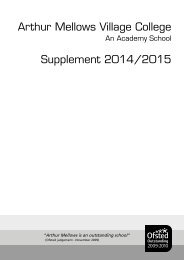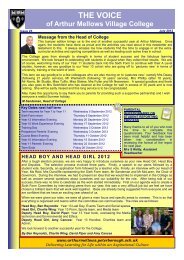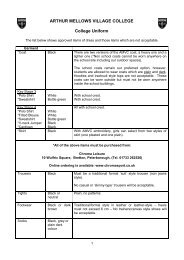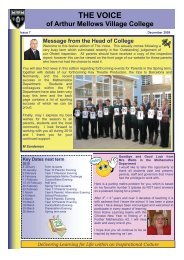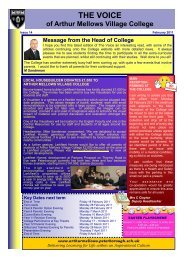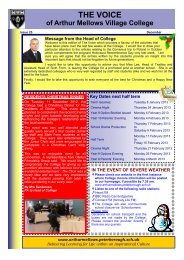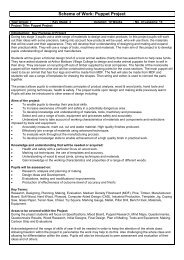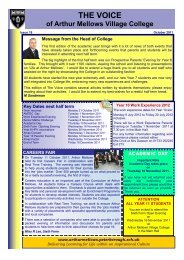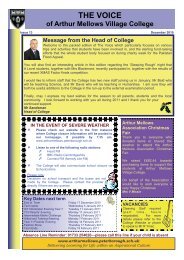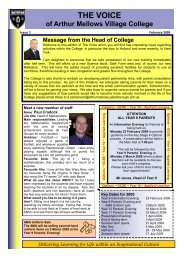Design and Technology Resistant Materials
Design and Technology Resistant Materials
Design and Technology Resistant Materials
You also want an ePaper? Increase the reach of your titles
YUMPU automatically turns print PDFs into web optimized ePapers that Google loves.
DESIGN AND TECHNOLOGYGCSE RESISTANT MATERIALS
IntroductionGCSE RESISTANT MATERIALSThis course has a clear <strong>and</strong> simple structureto help students revise for <strong>and</strong> relate the workdone for Controlled Assessment to the exam.There is a practical approach that encouragesstudents to design <strong>and</strong> make products withcreativity <strong>and</strong> originality in a variety ofpractical activities, using a range of materials<strong>and</strong> techniques.A working knowledge of woods, metals,plastics <strong>and</strong> composite materials are requiredbut other materials may be used in addition.
Year 10GCSE RESISTANT MATERIALSStudents focus on a number of small design<strong>and</strong> make activities / projects. Each projectwill focus on a number of skills / techniques<strong>and</strong> allow students to work with differentmaterials including woods, metals, plastics,composite materials <strong>and</strong> SMART materials.This year focuses on developing studentsskills <strong>and</strong> knowledge of the subject area.Lessons are divided into folder work, practical<strong>and</strong> theory based sessions.
GCSE RESISTANT MATERIALSYear 11A single design-<strong>and</strong>-make activity selected from achoice of set tasks, consisting of the developmentof a made outcome <strong>and</strong> a concise design folder<strong>and</strong>/or appropriate ICT evidence. These tasks arereviewed every two years.The design folder should consist of approximately:• 20 pages of A3 paper• equivalent A4 paper• or the ICT equivalent.It is expected that students should spendapproximately 45 hours on this activity.As part of the evidence submitted, students shouldinclude photographs of the finished products aswell as photographs at various stages of theprocess.
GCSE RESISTANT MATERIALSExam Board: AQACoursework folder: Controlled Assessment· 90 marks· 60% of the total marksExam: Written Paper· 2 hours· 120 marks· 40% of the total marksOne paper with two sections:Section A: A design question based on contextsupplied before the exam (30 marks)Section B: Covers all aspects of the specificationcontent (90 marks)
GCSE RESISTANT MATERIALSWho is it suitable for?• Anyone• Students who enjoy the challenge of problem solving• Underst<strong>and</strong>ing how products are made in industry• ‘H<strong>and</strong>s-on approach’ to learning• Develop a range of practical skills• Be creative <strong>and</strong> innovativeWhat could it lead to?• A-Levels in <strong>Resistant</strong> <strong>Materials</strong> or Product <strong>Design</strong>• Diplomas in Engineering <strong>and</strong> Manufacture• Product <strong>Design</strong>• Industrial <strong>Design</strong>• Automotive <strong>Design</strong>• Teaching• Furniture <strong>Design</strong>• Architecture• Manufacturing• CAD / CAM <strong>Design</strong>• Engineering
GCSE RESISTANT MATERIALSFor every lesson students are required to have:· Basic Graphics Equipment· A3 Portfolio: Purchased from school at a cost of £2Text Book Available:AQA GCSE <strong>Design</strong> <strong>and</strong> <strong>Technology</strong>:<strong>Resistant</strong> <strong>Materials</strong> <strong>Technology</strong>ISBN-13: 978-1408502730Homework:Homework tasks will be an integral part of thecourse. Additional time is expected to be spentoutside of lessons on folder <strong>and</strong> practical work duringYear 11. Lunch <strong>and</strong> after school clubs are availablefor students at any stage.



